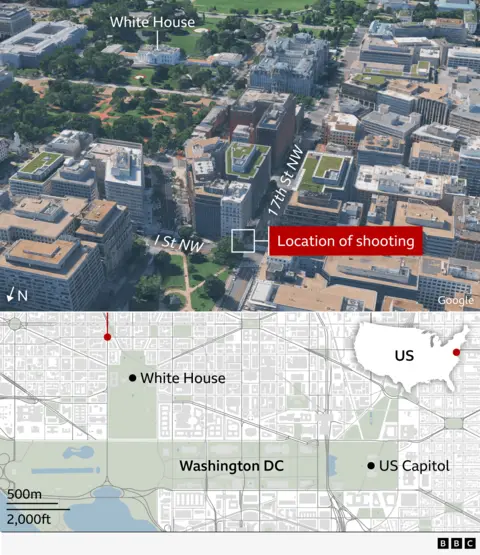US suspends immigration requests for Afghans after National Guard shooting
The US has suspended processing all immigration requests from Afghans, after an Afghan man was identified as the suspect in the shooting of two National Guard soldiers near the White House.
The US Citizenship and Immigration Services said the decision was made pending a review of “security and vetting protocols”.
The suspect of Wednesday’s shooting, which left two National Guard members critically injured, is said to have arrived in the US from Afghanistan in September 2021.
US President Donald Trump said the attack was an “act of terror”, adding that he would take steps to remove foreigners “from any country who does not belong here”.
Tens of thousands of Afghans entered the US under special immigration protections following the chaotic US withdrawal from the country in 2021 under former President Joe Biden.
The Department of Homeland Security named the suspect in a press release as Rahmanullah Lakanwal, “a criminal alien from Afghanistan”.
It said Lakanwal had entered the US during the presidency of Joe Biden in September 2021, under a programme for Afghans named called Operation Allies Welcome.
At the time, the Taliban had taken back control of Afghanistan following a chaotic withdrawal of US forces.
An official told the BBC’s US news partner CBS that Lakanwal had applied for asylum in 2024, and that his application had been granted earlier this year.
Lakanwal’s is reportedly 29 years old, and he is said to not be co-operating with authorities’ investigation.
Trump said following the shooting that the US “must now re-examine every single alien who has entered our country from Afghanistan under Biden”.

The Joint Task Force DC, which is co-ordinating the National Guard deployments to the nation’s capital, said the attack took place at around 14:15 EST (19:15 GMT) on Wednesday near the Farragut Square Metro Station.
The soldiers had been on a high-visibility patrol near the corner of 17th and I streets – a busy lunch spot for office workers.
Metropolitan Police Assistant Chief Jeff Carroll said the suspect “came around the corner” and “immediately started firing”, adding that the soldiers had been “ambushed”.
Other National Guard members nearby heard the gunfire and intervened, holding the suspect down until police arrived, he said.
The suspect was shot four times, law enforcement sources told CBS.
One witness described to the BBC his experience of hearing gunshots, as people ran in panic and tried to take shelter in a nearby shop.
Another witness, who was in his car close to the metro station, showed the BBC footage he took of the two soldiers lying on the street in their uniforms while being treated by medics. Details on the identities of the soldiers have not yet been provided by officials.
A third person, apparently the alleged gunman, was also seen on the pavement being treated.

In the wake of the attack, US Defence Secretary Pete Hegseth said the president had asked him to send 500 more National Guard members to the American capital.
“This will only stiffen our resolve to ensure that we make Washington DC safe and beautiful,” the Pentagon chief said.
There are currently nearly 2,200 National Guard troops in the city.
They are a reservist force that can be activated to serve as military troops, but have limited power as they cannot enforce the law or make arrests.
The troops were deployed in August to tackle what Trump called “out of control” crime in Washington.
Overall crime in the city has fallen since the force was sent, which Trump credits to the troops’ presence on the streets.
There have been similar deployments in other Democratic-led cities across the US, which have faced legal challenges by opponents who accuse the Trump administration of overreach.
Trump imposed a travel ban on nationals of Afghanistan – and 11 other countries – earlier this year.
Afghan nationals holding Special Immigration Visas – available to those who worked directly with the US military and feared retribution from the Taliban as a result of that co-operation – were among a few exceptions to the sweeping bans.
The Taliban returned to power following the US withdrawal in 2021.
Trump has also ended a programme that granted deportation protections for thousands of people from Afghanistan.
The temporary protected status programme allowed migrants to get work permits if the US government deemed it unsafe for them to return to their home countries due to war.
Additional reporting by Tom Bateman
Follow the twists and turns of Trump’s second term with North America correspondent Anthony Zurcher’s weekly US Politics Unspun newsletter. Readers in the UK can sign up here. Those outside the UK can sign up here.